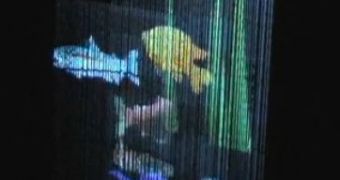A new projection system called AquaLux 3D was presented today by the Carnegie Mellon University. This is one of many approaches that have been tried - one more small step towards virtual-reality. The researchers' goal is to project three-dimensional moving images in a way that you can interact with them.
Until now, image projection on fast-spinning mirrors in an enclosed space (at the University of Southern California's Institute for Creative Technologies) and video projection used on a curtain of mist or fog, were experimented. You can actually see this in Disney's “Fantasmic” show, on a Heliodisplay demonstration or at a FogScreen presentation. A few years back, Mitsubishi had a project called Submerging Technologies, that used light projections and sensors to interact with water sculptures.
These gadgets were presented at the annual SIGGRAPH (Special Interest Group on GRAPHics and Interactive Techniques) showcase. The AquaLux 3D system, which relies on water and light as its name indicates, will also be presented in Los Angeles, later this month. The researchers at the Carnegie Melon University first tried to develop LED automobile headlights especially for driving through the rain at night. They wanted to control the light beam so that it could actually shine between the raindrops, instead of simply reflecting off them. "What we realized is that it was much easier to shine light on the drops themselves," robotics professors Srinivasa Narasimhan said.
The AquaLux system can control a single video projector and a high-speed water drop emitter to create a precisely calibrated image in 3D. The principle is the same as the two-dimensional image build by pixels on television or computer screen. For the SIGGRAPH presentation, the researchers demonstrated what they call a 2.5-D system: images projected on five sheets of water droplets, created by emitters capable of putting out 60 drops per second from each valve. The system can project text and video images and even a multilayered Tetris game or a virtual aquarium.

 14 DAY TRIAL //
14 DAY TRIAL //